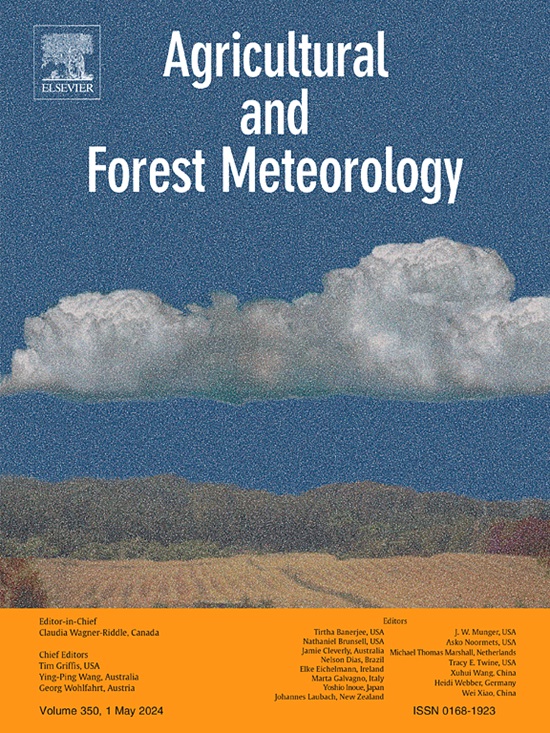Warming temperatures and decreasing soil moisture are increasing tree mortality in mature Douglas-fir forests of western Oregon, USA
IF 5.6
1区 农林科学
Q1 AGRONOMY
引用次数: 0
Abstract
Temporal patterns of tree mortality were determined for naturally regenerated Douglas-fir-dominated (Pseudotsuga menziesii (Mirb.) Franco) conifer stands, aged from about 125 to 500+ years, along an elevational gradient in western Oregon, USA based on periodic mortality surveys. Tree mortality increased from 2000 to 2023, a prolonged period of drought and warming. Soil moisture, air temperature, and vapor pressure deficit (VPD) were the key climatic predictors of tree mortality for all sites, species, and canopy classes based on logistic regression modeling. Increasing trends in annual probability of mortality were associated with decreasing summer available soil water and increasing summer temperature and associated VPD. These trends were most pronounced at mid-elevation (∼600 m) sites west of the Cascade crest, and they were higher for small diameter trees in suppressed and intermediate canopy class positions compared with co-dominant and dominant trees for all sites and species. Competition exacerbated the climate effects on mortality of small trees at drier sites. Insect-induced mortality was evident in large Douglas-fir following prolonged drought and high summer temperatures. In recent decades, long-term soil drying associated with warming temperatures appears to underlie tree mortality in these mesic forests of western Oregon.
美国西部俄勒冈州道格拉斯冷杉成熟森林温度升高和土壤湿度下降导致树木死亡率上升
测定了以道格拉斯冷杉为主的自然再生孟氏假杉(pseudosuga menziesii, Mirb.)树木死亡率的时间格局。根据定期死亡率调查,美国俄勒冈州西部沿海拔梯度分布的针叶树林龄约125年至500年以上。从2000年到2023年,树木死亡率上升,这是一段长时间的干旱和变暖。基于logistic回归模型,土壤湿度、气温和水汽压差(VPD)是所有立地、树种和冠层分类树木死亡的关键气候预测因子。年死亡概率的增加趋势与夏季有效土壤水分的减少和夏季温度的升高以及相关的VPD有关。这些趋势在Cascade峰顶以西的中高海拔(~ 600 m)站点最为明显,并且与所有站点和物种的共优势树和优势树相比,处于抑制和中级冠层位置的小直径树的趋势更高。竞争加剧了气候对干旱地区小树死亡率的影响。在长期干旱和夏季高温后,大道格拉斯冷杉的昆虫致死性很明显。近几十年来,与变暖有关的长期土壤干燥似乎是俄勒冈州西部这些mesic森林树木死亡的根本原因。
本文章由计算机程序翻译,如有差异,请以英文原文为准。
求助全文
约1分钟内获得全文
求助全文
来源期刊
CiteScore
10.30
自引率
9.70%
发文量
415
审稿时长
69 days
期刊介绍:
Agricultural and Forest Meteorology is an international journal for the publication of original articles and reviews on the inter-relationship between meteorology, agriculture, forestry, and natural ecosystems. Emphasis is on basic and applied scientific research relevant to practical problems in the field of plant and soil sciences, ecology and biogeochemistry as affected by weather as well as climate variability and change. Theoretical models should be tested against experimental data. Articles must appeal to an international audience. Special issues devoted to single topics are also published.
Typical topics include canopy micrometeorology (e.g. canopy radiation transfer, turbulence near the ground, evapotranspiration, energy balance, fluxes of trace gases), micrometeorological instrumentation (e.g., sensors for trace gases, flux measurement instruments, radiation measurement techniques), aerobiology (e.g. the dispersion of pollen, spores, insects and pesticides), biometeorology (e.g. the effect of weather and climate on plant distribution, crop yield, water-use efficiency, and plant phenology), forest-fire/weather interactions, and feedbacks from vegetation to weather and the climate system.

 求助内容:
求助内容: 应助结果提醒方式:
应助结果提醒方式:


